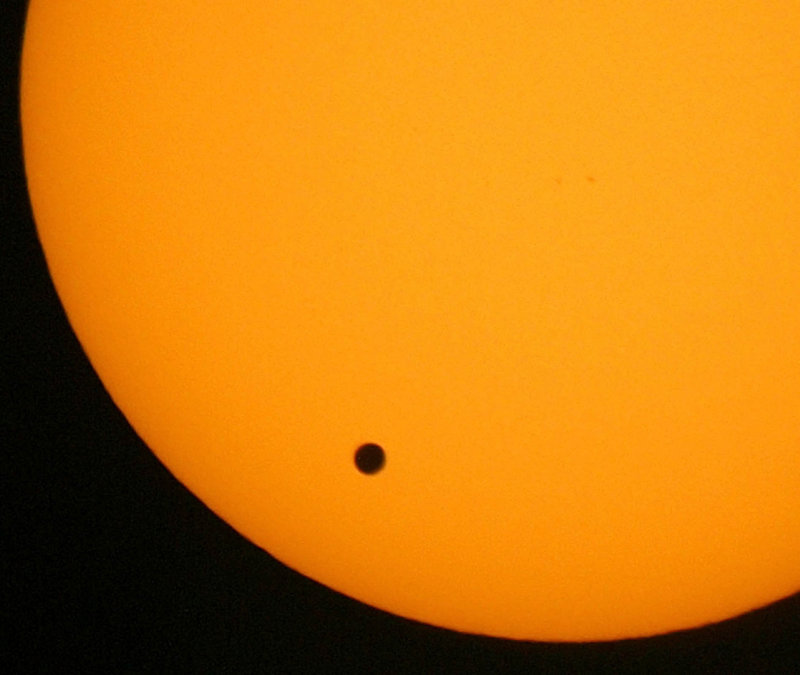There aren’t too many people on Earth today who will be around to see Venus pass by the sun again after Tuesday.
And a cloudy forecast could prevent people in Maine from witnessing the rare astronomical event this time.
The transit of Venus occurs in pairs, twice during an eight-year period every 105 to 112 years.
The last time it happened was in June 2004, and after Tuesday, the next time will be December 2117.
Local astronomers are crossing their fingers for good weather when Venus first starts crossing the sun at 6:03 p.m. Tuesday.
Astronomer Edward Gleason said, if the weather’s clear, local viewers will be able to watch the planet, which will look like a little black dot, travel about one-third of the way across the sun until it sets at 8:19 p.m. The entire transit takes about seven hours, he said.
Gleason is the manager of the University of Southern Maine’s Southworth Planetarium, which will have a show about the transit of Venus in its dome at 5 p.m. Tuesday, then plans to take telescopes out to the Western Promenade to watch it happen.
The planetarium will also have protective glasses for people to wear at the event. They’ll also be for sale, at $1.25 apiece, today and during the day Tuesday for people who want to watch the transit elsewhere.
Gleason warns not to look at the sun with bare eyes or through a telescope that doesn’t have the correct protective covering.
If the weather doesn’t cooperate, the planetarium will project a live Web feed of the event from the Mount Wilson Observatory in California.
He said there will be space for about 70 people, and reservations are recommended. Admission is by donation.
Poor weather prevented Gleason’s group from witnessing the event in 2004. That time, the end of the transit would have been visible from Maine, so telescopes were set up on the Eastern Promenade.
There isn’t a good western view from the Astronomical Society of Northern New England’s Kennebunk observatory, so that group is planning to watch Tuesday from a ridge in the Wells Reserve at Laudholm, which is asking for a $2 donation, said Ron Burk, president of the society.
Burk said the sun is 30 times the size of Venus, and Earth is slightly larger than Venus.
Watching the transit, he said, “gives you a perspective on the distances and how small our world is relative to the sun.”
Astronomers in the 18th century used the transit of Venus to determine the distance between Earth and the sun, Gleason said.
There will be more about the history and science behind the transit during the planetarium show, which has been playing in the dome in Portland since Friday, he said. There are shows tonight at 7 and 8.
Other viewings of the transit of Venus on Tuesday are planned at Acadia National Park, where telescopes will be set up in the Blue Hill overlook parking area near the summit of Cadillac Mountain, and at the L.C. Bates Museum on the campus of Goodwill-Hinckley in Fairfield.
But a storm system that’s expected to hang around New England through midweek could put a damper on the events, said meteorologist Bob Marine of the National Weather Service in Gray.
“I hate to be the bearer of bad news, but it doesn’t look good,” he said.
Staff Writer Leslie Bridgers can be contacted at: 791-6364 or at
lbridgers@pressherald.com
Send questions/comments to the editors.




Success. Please wait for the page to reload. If the page does not reload within 5 seconds, please refresh the page.
Enter your email and password to access comments.
Hi, to comment on stories you must . This profile is in addition to your subscription and website login.
Already have a commenting profile? .
Invalid username/password.
Please check your email to confirm and complete your registration.
Only subscribers are eligible to post comments. Please subscribe or login first for digital access. Here’s why.
Use the form below to reset your password. When you've submitted your account email, we will send an email with a reset code.